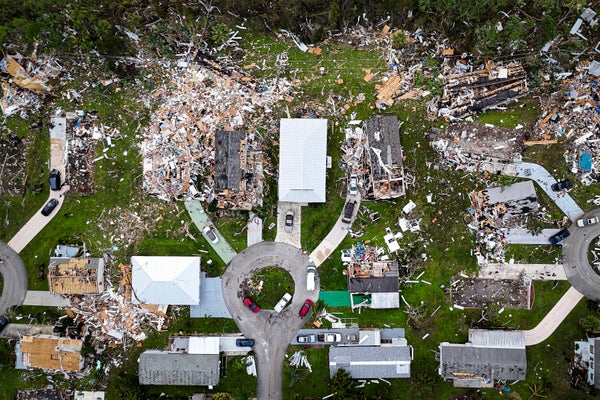Record Displacement Due to Disasters in 2024
By Chelsea Harvey & E&E News

Aerial view of destroyed houses in Port St Lucie, Florida, after a tornado hit the area as Hurricane Milton swept through on October 11, 2024.
Credit: Miguel J. Rodriguez Carrillo/AFP via Getty Images
Overview of Displacements
In 2024, internal displacements due to disasters and conflicts surged, impacting approximately 66 million individuals globally. The United States accounted for 11 million of these displacements, marking an unprecedented rise in domestic relocations.
According to the Internal Displacement Monitoring Centre (IDMC), about 46 million people worldwide were forced to relocate because of natural disasters alone last year. This figure surpasses the previous record for global displacements since monitoring began in 2008.
Contributing Factors to Displacement
The significant rise in displacements stems from various natural disasters, including hurricanes, floods, and wildfires. In the United States, the primary drivers were cyclones and floods. For instance, Cyclone Milton and its aftermath particularly highlighted these trends, resulting in significant evacuations and damage.
- More than 50% of global displacements were caused by cyclones.
- Hurricanes Helene and Milton contributed significantly to U.S. relocations.
- Floods were responsible for 42% of disaster-related movements globally.
- Over 8.3 million preemptive evacuations occurred in 2024, including around 6 million just from Hurricane Milton.
Impacts of Climate Change
Climate change is exacerbating the frequency and intensity of extreme weather events. The IDMC warns that inadequate infrastructure and urban development in disaster-vulnerable areas amplify the impacts of these events, especially in low and middle-income countries.
In Brazil, for example, catastrophic flooding in Rio Grande do Sul resulted in over 180 fatalities and displaced approximately 775,000 individuals, primarily affecting marginalized communities.
Compounding Crises and Their Consequences
The convergence of natural disasters and conflicts is increasingly evident. The report notes that countries experiencing both types of displacements have tripled since 2009, indicating a multi-faceted crisis that requires immediate attention and actions to foster resilience.
In the Democratic Republic of the Congo, heavy rainfall caused floods while ongoing conflicts restricted access for humanitarian aid, complicating recovery efforts for more than 5 million displaced individuals.
The Path Forward
While some displaced individuals manage to return home after disasters, many remain uprooted for extended periods. By the end of 2024, about 83.4 million people were living in displacement globally, with roughly 73.5 million displaced due to conflicts—a 10% increase over the previous year. Disaster-related displacements also saw a 29% rise, totaling about 9.8 million people.
“Resolving displacement requires both immediate efforts to help people who have lost everything and investments to address underlying vulnerabilities, so people don’t become displaced in the first place,” said IDMC Director Alexandra Bilak.


